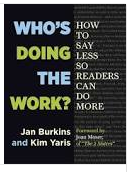It’s Monday What Are You Reading? Cognitive Load Edition
March 27, 2017
Recently, I have been lingering over lessons and concepts, giving students time to understand more fully, considering the gradual release of responsibility in a more thoughtful way, scaffolding the ideas of something we have worked on into other areas. Isn’t rigor something more than just difficult? Note: My links will send you to Heinemann and Stenhouse sites rather than Amazon. It’s here that you will get more information, videos, and sample chapters. sk
Disclaimer: This might seem like a crash course in literacy instruction.
 Preventing Misguided Reading, Jan Miller Burkins and Melody Croft
Preventing Misguided Reading, Jan Miller Burkins and Melody Croft
The Next Generation of Reading Instruction
This book is a GPS for the driving purposes behind quality literacy instruction.
Through structures in place, we can provide students with the environment to think critically and read closely. The authors strategically use preassessment to reduce cognitive load.
From the author:
“As you read this book, you will feel like you are having a stimulating professional conversation. You will agree, disagree, question, but most importantly, you will reflect. And after that, you will want to talk. For teachers…looking to think hard about the quality of their guided reading instruction, Preventing Misguided Reading promises to be the perfect study group companion.” — Kim Yaris, Educational Consultant, Plainview, NY.
 The Construction Zone, Thompson
The Construction Zone, Thompson
The subtitle says it all: Building Scaffolds for Readers and Writers. While I love this whole book, today I’m recommending Chapters 4 and 5 which focus on flexible design and flexible delivery. We can get caught up on delivery curriculum and lose sight of the learners.
In Thompson’s words,
If something isn’t working or if learners need more (or less) assistance, we counter by shifting our levels of support up or down as our scaffold moves closer and closer to its intended target. In this way, scaffolding is alive and organic.
 Teaching Reading in Small Groups, Serravallo
Teaching Reading in Small Groups, Serravallo
In Serravallo’s own words:
We believe reading instruction should: ❏ match the individual reader ❏ teach toward independence ❏ teach strategies explicitly so that readers become proficient and skilled ❏ value time spent, volume, and variety of reading ❏ follow predictable structures and routines
We wrote that in a reader’s workshop classroom, we are reading mentors, and conferences are an opportunity for us to model the kinds of reading habits and skills we use to support student readers to do the same in their own reading.
This book is for anyone that is reconsidering their small group and perhaps whole class instruction, for teachers who wonder why their students aren’t making the progress they hope.
In their follow up book to Reading Wellness, Burkins and Yaris hit us right between the eyes. In their words,
When we are mindful about allowing students to actively engage their reading processes, each of these instructional context contribute to children rich reading growth.
This book covers building agency in read aloud, shared reading, guided reading, and independent reading. Caution: They are tough on teachers, so be prepared to look closely at your practices and not take offense.
 Notice and Note- Strategies for Close Reading
Notice and Note- Strategies for Close Reading
Grade 3-8
I just can’t say it better than the authors themselves. Here is a book that gives concrete systematic ways to reveal text to students. Sidenote: follow Beers on Twitter @KyleneBeers and Facebook. She does not hold back.
Check out their Rigor and Talk Checklist.
Just as rigor does not reside in the barbell but in the act of lifting it, rigor in reading is not an attribute of a text but rather of a reader’s behavior—engaged, observant, responsive, questioning, analytical. The close reading strategies in Notice and Note will help you cultivate those critical reading habits that will make your students more attentive, thoughtful, independent readers.”
—Kylene Beers and Robert E. Probst
Also, Readers Front and Center, reviewed here.
For Students:
An amazing book for anyone who has been, well, stuck. Problem solving abounds.
 The Most Magnificent Thing Ashley Spires
The Most Magnificent Thing Ashley Spires
Sometimes we can’t quite see where we are going until we look again with fresh eyes.
 Thank you, Two Writing Teachers for the March Slice of Life Challenge. Read more slices here.
Thank you, Two Writing Teachers for the March Slice of Life Challenge. Read more slices here.
 Who is Doing the Work?
Who is Doing the Work?  Stuck Oliver Jeffers
Stuck Oliver Jeffers
What a great list of professional books. There are a few on here that I will need to read!
That is a great list of resources! Makes me want to hide my amazon account from my husband! Thanks for sharing, think I found lots of new books for my summer reading list.
Great list- I have read some and want to read a few of the others. I love breaks where I can od on reading!
Thank you for the recommendations. I especially appreciate the children’s books. Loved both.
Some of this professional reading, I’ve dune, and some I need to do. Thanks for the pointers.
Thanks for the recommendations! I have read a few of these. I love everything by Jennifer Serravallo. A few of the titles, I have never seen. Who’s Doing the Work? has been on my shelf for a while now. That may be my next read! It was nice to see your thoughts on each of these resources.
Great list — love the quotes you picked for each!! Thank you for sharing — some of my favorites too.
Clare